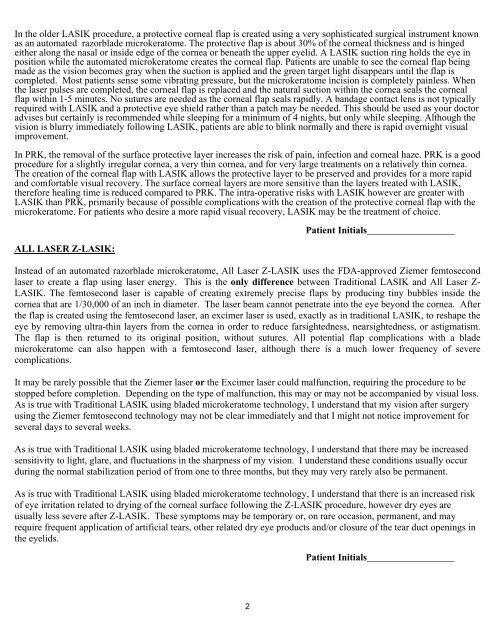lasik informed consent - initial - Braverman Eye Center
lasik informed consent - initial - Braverman Eye Center
lasik informed consent - initial - Braverman Eye Center
Create successful ePaper yourself
Turn your PDF publications into a flip-book with our unique Google optimized e-Paper software.
In the older LASIK procedure, a protective corneal flap is created using a very sophisticated surgical instrument known<br />
as an automated razorblade microkeratome. The protective flap is about 30% of the corneal thickness and is hinged<br />
either along the nasal or inside edge of the cornea or beneath the upper eyelid. A LASIK suction ring holds the eye in<br />
position while the automated microkeratome creates the corneal flap. Patients are unable to see the corneal flap being<br />
made as the vision becomes gray when the suction is applied and the green target light disappears until the flap is<br />
completed. Most patients sense some vibrating pressure, but the microkeratome incision is completely painless. When<br />
the laser pulses are completed, the corneal flap is replaced and the natural suction within the cornea seals the corneal<br />
flap within 1-5 minutes. No sutures are needed as the corneal flap seals rapidly. A bandage contact lens is not typically<br />
required with LASIK and a protective eye shield rather than a patch may be needed. This should be used as your doctor<br />
advises but certainly is recommended while sleeping for a minimum of 4 nights, but only while sleeping. Although the<br />
vision is blurry immediately following LASIK, patients are able to blink normally and there is rapid overnight visual<br />
improvement.<br />
In PRK, the removal of the surface protective layer increases the risk of pain, infection and corneal haze. PRK is a good<br />
procedure for a slightly irregular cornea, a very thin cornea, and for very large treatments on a relatively thin cornea.<br />
The creation of the corneal flap with LASIK allows the protective layer to be preserved and provides for a more rapid<br />
and comfortable visual recovery. The surface corneal layers are more sensitive than the layers treated with LASIK,<br />
therefore healing time is reduced compared to PRK. The intra-operative risks with LASIK however are greater with<br />
LASIK than PRK, primarily because of possible complications with the creation of the protective corneal flap with the<br />
microkeratome. For patients who desire a more rapid visual recovery, LASIK may be the treatment of choice.<br />
ALL LASER Z-LASIK:<br />
Patient Initials__________________<br />
Instead of an automated razorblade microkeratome, All Laser Z-LASIK uses the FDA-approved Ziemer femtosecond<br />
laser to create a flap using laser energy. This is the only difference between Traditional LASIK and All Laser Z-<br />
LASIK. The femtosecond laser is capable of creating extremely precise flaps by producing tiny bubbles inside the<br />
cornea that are 1/30,000 of an inch in diameter. The laser beam cannot penetrate into the eye beyond the cornea. After<br />
the flap is created using the femtosecond laser, an excimer laser is used, exactly as in traditional LASIK, to reshape the<br />
eye by removing ultra-thin layers from the cornea in order to reduce farsightedness, nearsightedness, or astigmatism.<br />
The flap is then returned to its original position, without sutures. All potential flap complications with a blade<br />
microkeratome can also happen with a femtosecond laser, although there is a much lower frequency of severe<br />
complications.<br />
It may be rarely possible that the Ziemer laser or the Excimer laser could malfunction, requiring the procedure to be<br />
stopped before completion. Depending on the type of malfunction, this may or may not be accompanied by visual loss.<br />
As is true with Traditional LASIK using bladed microkeratome technology, I understand that my vision after surgery<br />
using the Ziemer femtosecond technology may not be clear immediately and that I might not notice improvement for<br />
several days to several weeks.<br />
As is true with Traditional LASIK using bladed microkeratome technology, I understand that there may be increased<br />
sensitivity to light, glare, and fluctuations in the sharpness of my vision. I understand these conditions usually occur<br />
during the normal stabilization period of from one to three months, but they may very rarely also be permanent.<br />
As is true with Traditional LASIK using bladed microkeratome technology, I understand that there is an increased risk<br />
of eye irritation related to drying of the corneal surface following the Z-LASIK procedure, however dry eyes are<br />
usually less severe after Z-LASIK. These symptoms may be temporary or, on rare occasion, permanent, and may<br />
require frequent application of artificial tears, other related dry eye products and/or closure of the tear duct openings in<br />
the eyelids.<br />
Patient Initials__________________<br />
2






